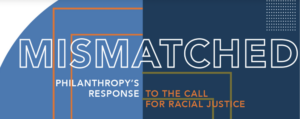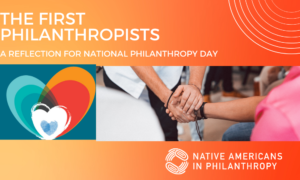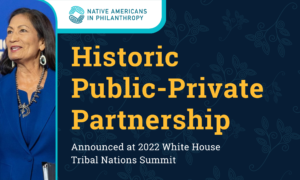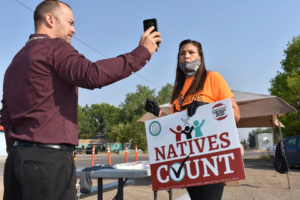Addressing racial healing is a challenging task that requires a variety of strategies.
To move towards racial healing, it is essential to acknowledge past injustices and their ongoing effects, to develop relationships based on mutual respect, and to value the strengths and uniqueness of Native communities.
At Native Americans in Philanthropy (NAP), we offer and point to several strategies and resources to pull from to further philanthropy’s racial healing.
Investing in Research and Data to Advance Equity in Philanthropy
It takes a tremendous amount of research and planning to understand the issues our communities face.
One of the most impactful ways that philanthropy can support racial healing is to invest in research and data practices led by Indigenous people. Such investments are a powerful tool in advancing Indigenous data sovereignty work, which is fundamental to the future of Indigenous communities.
In the recent Chronicle of Philanthropy article, Philanthropy’s Love of Data Must Extend to Underfunded and Frequently Ignored Indigenous People, NAP’s CEO, Erik Stegman, wrote, “Grantmakers have responded to the nation’s racial reckoning of the past few years by hosting diversity, equity, and inclusion training sessions for employees, switching to language that highlights the strengths of a given population rather than its challenges, and acknowledging how racism has influenced the nation’s programs and policies.
What they haven’t done is examine their own data practices and the data projects they fund. Without taking those steps, it is impossible to understand which distinct and diverse communities under the BIPOC umbrella are being helped — and which are left out.”
Investing in Movements and Organizing Networks
Foundations may find themselves wanting to engage with prominent voices around specific issues.
However, they must decide where their leverage lies with the public narrative. It may not necessarily include acting as a public messenger or increasing their own prominence in the field. Instead, foundations can help shift a narrative by leveraging resources to quickly fund Indigenous organizers and movements. 
According to Philanthropic Initiative for Racial Equity (PRE)’s latest report, Mismatched: Philanthropy’s Response to the Call for Racial Justice, to ensure that the needs and perspectives of communities of color and movements are effectively represented, funders should establish systems and processes that actively involve them in the development and implementation of strategic decisions and grantmaking priorities.
This includes seeking input and leadership from these communities and movements at all stages of the decision-making process, from the initial design and planning to the final execution and evaluation. By actively engaging and empowering these communities, funders can help ensure that their strategies and funding decisions are informed by the perspectives and experiences of those who are most impacted.
Intentional Relationship Building is Key to Effective Philanthropy
Funders hold significant power in their ability to support communities, but this power can often be wielded in ways that undermine the strengths and leadership of those communities. A crucial perspective is to view Indigenous communities by their strengths, recognizing that while we may have needs, we also possess incredible potential for philanthropic collaboration and partnership.
Native-led nonprofits have their own sources of power, such as trusted networks and relationships, and an understanding of solutions that work for their communities. Indigenous Peoples have always practiced philanthropy through our traditions, ceremonies, and ways of giving and sharing. Some Indigenous peoples and communities may be new to the philanthropic sector but they are not new to philanthropy.
Trust-based approaches may be new to many in the field, but they are long-held traditions for Indigenous people. Therefore, it is crucial to keep in mind the Native value of reciprocity in funding practices and relationship building. When philanthropy approaches Native communities with mutual respect and exchange in mind it results in being more intentional, thoughtful, and humble when interacting with the community they serve.
Given that Native people and communities are among the most underfunded in the country, it is of paramount importance that foundations are urged to act as responsible stewards of these relationships and follow the lead of grassroots initiatives and the leadership of Native individuals, Tribes, and communities.
Philanthropy and Policy: A Partnership for Racial Healing
To achieve meaningful policy change that positively impacts Indigenous communities, a coordinated effort is needed to raise awareness of crucial issues. This requires flexible investment in a diverse array of organizations that can empower community leadership to re-frame issues, form coalitions, advocate for increased funding, and drive policy change.
 NAP recently announced our new Office of Strategic Partnerships that will create long-term opportunities to foster public-private partnerships to support Tribally-led projects in the areas of conservation, education, and economic development.
NAP recently announced our new Office of Strategic Partnerships that will create long-term opportunities to foster public-private partnerships to support Tribally-led projects in the areas of conservation, education, and economic development.
NAP’s CEO, Erik Stegman, recently shared with Candid’s Philanthropy News Digest featured to share that our work in the policy space is necessary due to new investments from the Federal government in Indian Country. “…We felt the need for an office that’s focused on Indian Country to help us coordinate and prioritize across agencies: what those funding streams look like and where we can think about the highest-impact opportunities. One really important part of the office is to have a bird’s-eye view and be a coordinator across the different programs and agencies that work directly with Tribes. That’s one of the reasons we felt it was important that it was housed at the Bureau of Indian Affairs.”
To effectively address racial healing and the myriad of issues affecting our communities, it is crucial to invest in a diverse ecosystem of organizations that can support grassroot efforts and drive policy change.
Ultimately, meaningful and lasting change can be achieved through the leadership and empowerment of the individuals and groups directly impacted by these issues.
We appreciate all who engage in the work of equity and racial healing, and we are excited for those who join our work to increase the partnerships with Native people and communities, educate funders, establish meaningful relationships, and increase funding for Indigenous-led organizations, movements, and Tribal Nations.
Tags:
NAPJanuary 17, 2023

Comments